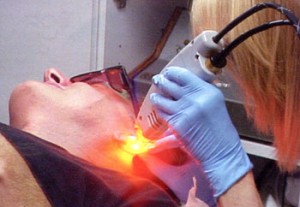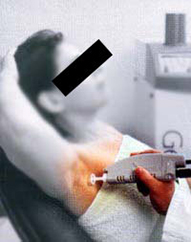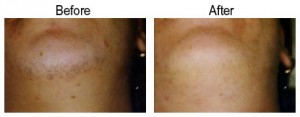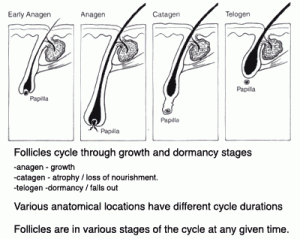Laser Hair Removal
Laser is a giant step forward in hair removal technology. It is a non-invasive, light energy that eliminates hundreds of hair follicles in an instant. Laser is an affordable state-of-the-art technology offering:
- Convenience
- Safe and gentle treatments
- Accuracy
- Increased effectiveness
- Immediate results with less follow-up visits
What are the Advantages of Laser Hair Removal?
Treatment of large body areas that once took months to perform with electrolysis can now be accomplished in less than an hour. Freedom from unwanted hair is faster, easier, and comfortably achieved because the laser treats many hairs with a single pulse. Laser technology is delicate enough for a woman’s fine, sensitive skin and yet strong and effective for a man’s coarse, tough hair.
Laser treatments leave your skin looking and feeling smooth and silken. The results can change your life dramatically.
How Does Laser Hair Removal Work?
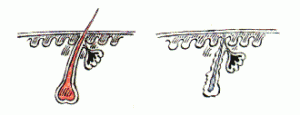 A small handpiece is used that allows a gentle beam of laser light to pass through the skin and to penetrate deep into the tissue, where it is selectively absorbed by the melanin, the dark pigment coloration present in the hair and hair follicle. This causes thermal damage to key structures – the bulge, hair bulb, and vascular supply – to eliminate unwanted hair without damaging the surrounding skin and tissue.
A small handpiece is used that allows a gentle beam of laser light to pass through the skin and to penetrate deep into the tissue, where it is selectively absorbed by the melanin, the dark pigment coloration present in the hair and hair follicle. This causes thermal damage to key structures – the bulge, hair bulb, and vascular supply – to eliminate unwanted hair without damaging the surrounding skin and tissue.
With careful selection of the wavelength, pulse width, spot size, energy and cooling method, the effectiveness of the laser on the target (hair follicle) is maximized while any heating of the surrounding tissue is minimized. The small surrounding structures remain cool while the target heats up to the destruction point.
Treatment energies for each patient will vary according to the patient skin type, location and density of the hair and its color. Test spots, using a variety of different levels of energies and pulse widths are performed in our office before treatment begins. This test spotting will help the practitioner to know the skin reaction and exactly what laser levels to use. This will ensure that energy tested on the patient is within safe and effective parameters.
Once the screening evaluation is done, a course of treatment is then decided upon and begun. It is recommended to wait 24-48 hours before the actual treatment begins. Most individuals, even those with extremely persistent hair growth, achieve permanent hair reduction after six or eight treatments.
How Long will it Take to Remove the Hair? How Many Laser Treatments Will I Need?
To answer this question one must consider all the variables. Many different factors determine the length of time necessary to completely remove all your unwanted hair.
- Type of hair – straight, wavy or curly.
- Type of skin – normal or sensitive, as well as fair or dark in color.
- Metabolic rate – how quickly your skin heals and how quickly your hair grows.
- Cause of the hair growth plus hormonal influences.
- Density and color of the hair.
- Location of the hair.
- Fluence levels used
- Medications
- Temporary methods of hair removal previously used.
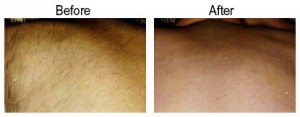
Hair Growth Cycles
Each follicle in human skin maintains an independent growth rhythm from the other follicles. At any given time the majority of hair follicles grow in 3 different cycles, from an active or growth phase (anagen) during which the laser absorption is most effective due to an abundance of melanin, to a resting phase (catagen) during which the hair bulb regresses and begins to shrink, to a dormant – shedding phase (telogen) when the old hair falls out in preparation for the development of a new hair. During telogen there is little or no melanin in the hair follicle and the laser will not be effective.
The laser works by disabling hairs that are in the active growth phase at the time of treatment. Hairs lying dormant will not be affected. Repeated treatments will be necessary to disable all the hair follicles as they reenter the growth cycle. It appears that after the first initial treatment of the laser, the hairs that regrow are synchronized into the early anagen phase, where they are most vulnerable to laser light treatment. That is why the second treatment is so important and why it is necessary to maintain a strict schedule of treatments at fixed intervals.
The laser is able to treat any active anagen hair follicle even if the hair has not yet appeared or reached the surface of the skin. The laser can also treat the hair if the hair shaft is not straight (curly or crooked).The certified laser specialist will work with you to develop the personalized treatment program and exact laser parameters that best meet your hair removal needs.
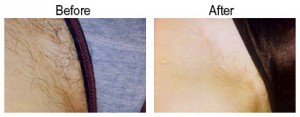
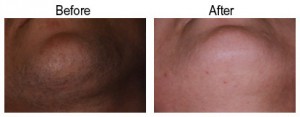
Are There Any Special Considerations?
- Safety eyewear is worn to protect the patient’s eyes from the laser light.
- Waxing and tweezing and the use of depilatories and electrolysis must be discontinued 3 weeks prior to treatment. Hairs are necessary to serve as dark elongated targets for the laser energy. The area may be shaved clean before the day of treatment.
- Sunlight should always be avoided before and after treatment and sunscreens with SPF 30 or higher should be applied daily. Newly tanned skin cannot be treated until the tan has faded. This includes UV light from a tanning booth and those tans from tanning creams.
- Traditional electrolysis can be performed on sparse growth or persistent regrowth. White, gray or blonde hair cannot be successfully treated with laser due to a lack of pigment. Electrolysis would then be recommended.
- Anywhere from 5-30 days after the treatment, shedding of the hair that was left in the follicle may occur and this appears as new hair growth. It is not new hair growth but dead hair rising to the surface and working it’s way out of the follicle. It can be removed by washing or wiping the area with a wet wash cloth or loofa and keeping the area well moisturized.
Are There Any Side Effects?
- Laser technology rapidly removes hair with a new level of effectiveness and convenience. Most individuals experience no more than a slight stinging sensation. Short-term side effects may include a slight reddening of the skin or minimal local swelling and will subside within an hour or two. They are desired clinical side effects that indicate that the patient has been treated appropriately. Applying ice will give relief and reduce the swelling duration. Aloe, Vitamin E, antibiotic creams or ointments and/or topical cortisone may also be used.
- In rare instances there may be itching, blistering or scabbing , as well as temporary pigment changes (hyper and hypo pigmentation).
- The treated area may have a mild sunburn-like sensation that quickly disappears after 24 hours. Adverse effects are minimal and transient. Patricia Chauvin will work with you to develop the personalized treatment program that best meets your needs. It is extremely important for you to make a commitment to follow this schedule in order to achieve the desired results of beautiful, smooth, hair-free skin.






